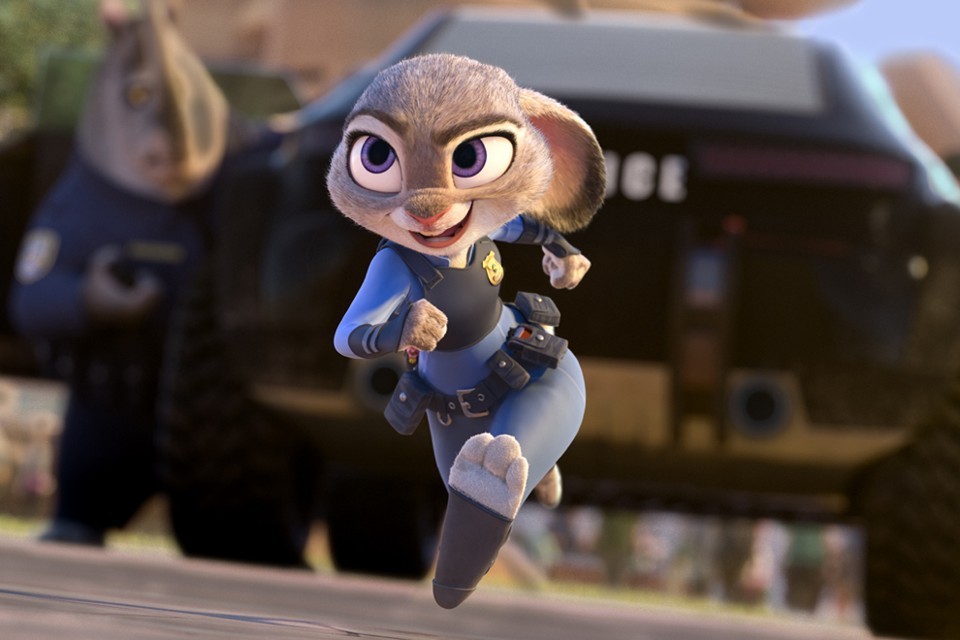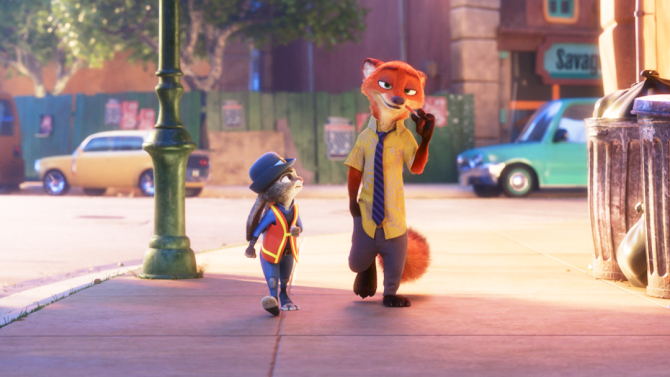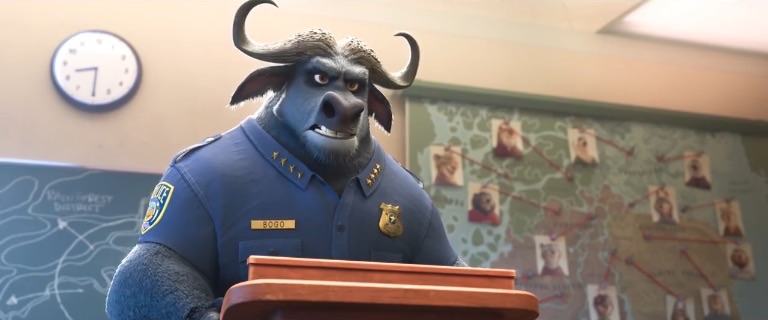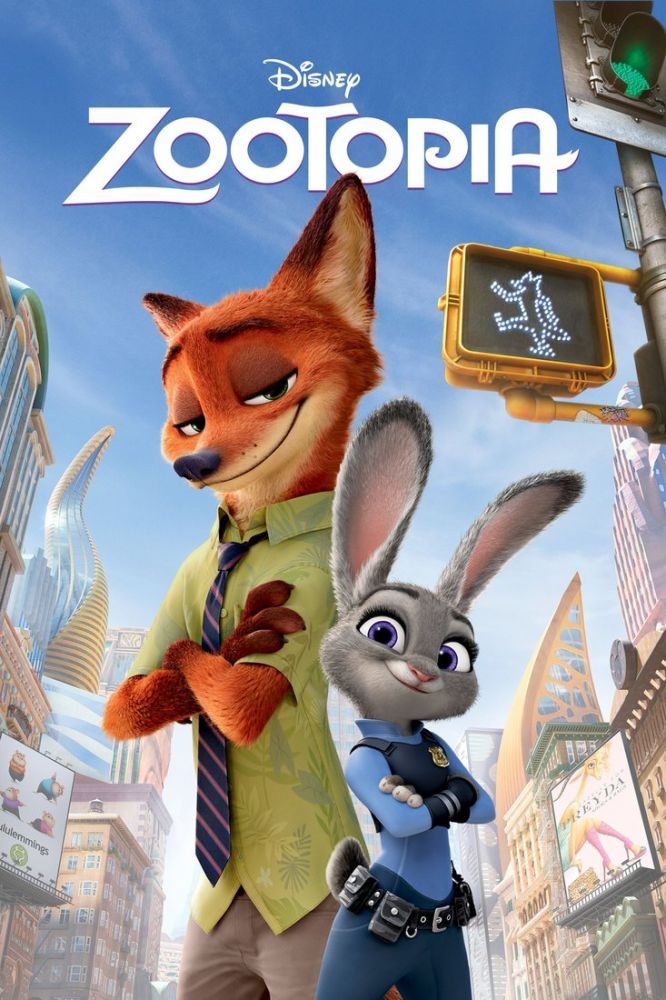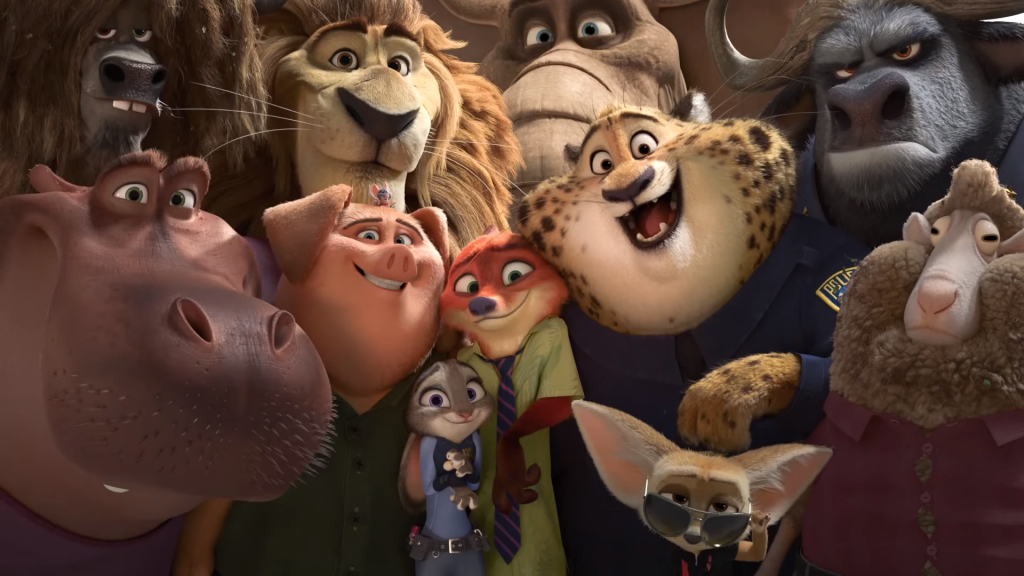Dreams can be powerful things; and to Judy Hopps, no dream is greater than becoming Zootopia’s first rabbit police officer. After years of chasing her goal however, Judy discovers that maybe her dream isn’t all it’s cracked up to be. Finding herself in a world dominated by bigger, stronger animals; Judy faces discrimination as she is relegated to the role of meter maid by the sour-faced buffalo Chief Bogo. While still determined to do her best, things go from bad to worse for Judy as she is humiliated by the devious fox confidence trickster Nick Wilde. In the face of her colleagues’ bigotry and her chaotic career; Judy is then forced to stake her career on solving a missing person case with nothing but a single page case file and a traffic buggy. Her solution? With a secret gift for trickery and sleight of hand, Judy dupes Nick into helping her; the pair forming an unlikely alliance as this supposedly simple missing person case stats to run deeper into the dark heart of Zootopia than anyone could’ve thought.
Zootopia [1] is an animated comedy-adventure with as much bounce and slick charm as its protagonists. Imaginative and endlessly expressive, Zootopia is a charming film that fits well into the Disney sense of universal appeal. Its setting is exotic yet familiar, filled with bright colour and detail; the film presenting a world which engages the minds of all audiences. Its writing and comedy are much the same; presenting a wide range of humour from more zany moments of physical comedy to more snappy, snarky dialogue. Zootopiais in every part a family film, appealing to a broad audience in a charming manner. However, Zootopia is more than just a family comedy-adventure. In looking at Zootopia’s animal characters; one can’t help but see Zootopia as an animal fable. The film holds many similarities to the classical fables written by Aesop; in that it is a story told through the medium of talking animals which conveys a clear moral message. In understanding Zootopia as a more contemporary take upon the Aesopian tradition one can come to understand how the film sees and uses its anthropomorphic cast.
Zootopia is like an Aesopian fable because of how it conveys its message through the medium of animal stereotypes. The idea of stereotype and stereotyping in literature is clearly close to the film’s heart; as can be seen in the characterisation of Judy and Nick. Not only does a story about a fox and a rabbit have a definite storybook feel to it; the film also gives personalities and behaviours stereotypical to foxes and rabbits in literature to its main characters, showing Zootopia‘s animal fable genre traits. This aspect of a fable’s style is conveyed by Nick when he first meets Judy; the fox patronisingly explaining their differences by using the phrase ‘Sly fox, dumb bunny.’ [2]. Animal fables characterise their animal cast through ascribing them human traits which are easily comparable to their species’ behaviour. This is not unlike Roland Barthes’s principle of modern myth; the idea that certain images and signs, in this case various different species of animal, provoke an automatic association to certain ideas. We expect foxes to be clever and devious just as we expect rabbits to be bouncy and naive.
It is not just our protagonists this applies to however; as many other animals we encounter in Zootopia embody an animal fable myth. The mayor of the city is a lion; one of the criminals Judy apprehends is a craven weasel who makes his living through theft and bootlegging; and, in a comedic scene at Zootopia’s DMV, we meet a group of bureaucratic sloths. Animal stereotypes serve an important function in an animal fable due to the ease by which they allow it to deliver its moral message. Morality is a complex subject; but mythological stereotypes allow a clear, universally understood categorisation of our experiences giving clarity to a piece’s moral message. At first glance, Zootopia uses this visual shorthand to show its audience the personalities and perspectives of its characters at a glance through their species and design. On meeting Chief Bogo for example, we can interpret him as a gruff, sour character from his appearance; his vast frame and fierce expression, often shown in low angle shots, dominate any scene like a black thundercloud. This combined with the fact that buffalo are famed for their foul tempers gives the audience an instant idea of his character the moment Bogo enters the frame.
Zootopia as an animal fable is further shown by how the filmanimates and designs its characters. Zootopia‘s animal cast is an anthropomorphic one; their society being a thoroughly contemporary one, reliant on technology. This raises the problem that often anthropomorphism falls afoul of characterising animals as simply humans with a different coat of paint; thus detracting from the idea of certain species being characterised by individual stereotypes. The characters of animal fables often have what Paul Wells, author of The Animated Bestiary [3], refers to as ‘hybrid humanimality’ [4]; their animal characters being able to speak alongside their world holding semblances to human society, but still being seen as wild animals. The animal characters of Zootopia retain a sense of animality, as opposed to being overly humanized, by how they are animated; many of the characters moving in more animalistic fashions. Judy moves in a fast, bouncy manner; her nose twitching when faced with difficult situations and she thumps her feet when angry. She moves in a way which reminds the audience of the behaviours of real rabbits; thus enforcing the importance of her identity as a rabbit as opposed to a simple human analogue. These animalistic quirks are reflected in the rest of the cast too. Nick shakes himself dry from the rain, giraffe characters use their prehensile tongue when they eat and drink; and Clawhauser, the exuberant cheetah police clerk, flicks, coils and swishes his tail to express emotions. Alongside this, Zootopia is uncommon in anthropomorphic media in that it realistically scales its characters. A mouse in Zootopia is as dwarfed by an elephant as it would be in the real world; this sense of size difference creating an arresting and unique composition in the film’s group shots and world design. This, alongside how the characters are animated, makes them feel closer to the animals they represent rather than them being human stand-ins; therefore strengthening the bond between these characters and what they represent in the mythological tapestry of Zootopia‘s animal fable.
However, there is an issue with using animals as modern myths. In Tom Tyler’s essay, Quia Ego Nominor Leo: Barthes, Stereotypes and Aesop’s Animals [5], Tyler talks about how philosophy and art has a tendency to characterise animals as either ‘ciphers’ [6] or ‘indexes’ [7]. A cipher animal is a phantom; a creature which solely exists to fill a role in argument or act as a plot device regardless of its unique identity or species. On the other hand, an index animal is different but no better in its reduction of unique animal personalities. Whilst an index animal is used because of a particular trait they possess, such as porcupines for their spines as Tyler mentions [8]; they are still being used as a functional part of an argument or plot rather than being respected as unique entities. What this boils down to is, due to an ingrained anthropocentrism, animals are often seen as lesser entities with poorer emotions and inner worlds; animals only being seen as accessories to human philosophy and art. As Tyler writes in his book Ciferae [9], ‘In trying to imagine a world without humanity, they try to see nothing…They use words to describe experiences that can only be experienced without words, without distinctions, without consciousness. In short, they produce nonsense’ [10]. Animal fables use their characters as indexes; using the mythological shorthand of species to convey its moral message. Due to this, the genre becomes tarred with the appropriation of animal characters; treating them as accessories to an anthropocentric point of view.
Taking this into consideration; does this mean Zootopia‘s depiction of its animal characters inherently anthropocentric? This, however, is where Zootopia takes a peculiar deviation from the classical mode of the animal fable. All animal fables have a moral message, Zootopia being no different; and this message is clearly highlighted in the film’s insert song ‘Try Everything’ [11]. The song, which appears both in the scene which introduces us to Zootopia and the final concert sequence; preaches a message of embracing the world around you despite hardship (‘Birds don’t just fly, they fall down and get up/Nobody learns without getting it wrong’ [12]). This song perfectly encapsulates what Zootopia‘s moral message is all about. Zootopia at its heart is a film about discrimination and the value of tolerance; which seems ironic given that it uses a form which relies on mythic stereotypes to tell its story. However, looking at Zootopia as a standard animal fable would only be seeing half the picture. The phrase ‘Sly fox, dumb bunny’ [13] Nick uses to describe his and Judy’s differences doesn’t stay static; in fact the phrase metamorphoses to eventual become ‘Sly bunny, dumb fox.’ [14]. Whilst Zootopia establishes a language of mythic stereotype for its animal cast; it does so only to subvert our expectations of the stereotypes we have been presented. For example the character of Clawhauser, whilst seeing himself as a walking stereotype (‘Me, Benjamin Clawhauser, the guy everybody thinks is just a flabby, donut-loving cop stereotyping you.’ [15]), defies the stereotypical mould set for him. He is a cheetah, which would normally characterise him as energetic and fast; whereas he is shown to be overweight and unfit. This trend of characters defying our expectations of their species is seen throughout the film; with examples such as an elephant with a terrible memory, a sloth bureaucrat named ‘Flash’ who gets caught speeding, and a crime boss named ‘Mr. Big’ who is actually a shrew.
In breaking down constructed myths of species Zootopia is able to draw our attention to the personalities of its characters rather than an enforced stereotype of their species; the emotional development of our protagonists revolving around them coming to see each other as complex individuals rather than walking stereotypes. In The Animal That Therefore I Am [16], theorist Derrida gives the idea that fresh thoughts about animals come from individual animals rather than treating animals as symbolic of their species [17]. Zootopia is still an animal fable, but a more self-reflective one. In making us expect characters to conform to mythic assumptions, in believing that all foxes are sly and all bunnies are dumb, the film then can defy our expectations through showing its animal characters as unique individuals rather than phantom ciphers. This therefore helps proves Zootopia‘s moral message of the danger of stereotypes. Zootopia has a moral message, as is the nature of animal fables to have; but it proves its message through the deconstruction of the genre. This attitude of animal representation is in fact best summed up by the film’s opening scene. The opening shows what might be expected of the animal world, a dark and ominous underbrush where a cute rabbit is hunted by a vicious tiger; however this scene is in fact an imagined scenario and part of a stage play put on by a young Judy. What we, as humans, expect of the animal world is shown to be false; the film defying how we expect a film focusing on animal characters to function. In this, we see that the characters of Zootopia have arisen beyond mythological stereotypes of the animal; just as Judy’s play shows how they also evolved from their primitive forms.
In this, Zootopia shares some similarities with the film Kung Fu Panda [18] in how it pairs back our expectations and prejudices of certain species. The film’s panda protagonist Po aspires to be a martial arts master despite how he is stereotyped for his species. Typically we associate the panda more with laziness than strength or speed; and Po is treated as a reject by his peers, all of whom are animals with folkloric associations to Chinese martial arts. Po is an anomalous figure; his success breaking the generic boundaries of animal stereotypes on which the film is built. Because of this, the film share similarities with Zootopia. Both films set to challenge our anthropocentric perspective of how animals are characterised in film; and that we should see them as unique individuals rather than grand analogies or phantasmal ciphers.
Further Reading
- John Simons, Animal Rights and the Politics of Literary Representation (Basingstoke: Palgrave Macmillan, 2002).
- David Whitley, The Idea of Nature in Disney Animation (Hampshire: Routledge, 2008).
- Roland Barthes, Mythologies, Neil Badmington (London: Vintage, 2009).
Bibliography/Filmography
- Zootopia. Dir. Byron Howard and Rich Moore. Walt Disney Studios Motion Pictures, 2016.
- Paul Wells, The Animated Bestiary (New Jersey: Rutgers University Press, 2009).
- Tom Tyler, ‘Quia Ego Nominor Leo: Barthes, Stereotypes and Aesop’s Animals’, Tom Tyler: Reseach (2007) < http://www.cyberchimp.co.uk/research/aesop.htm> [17/12/2016].
- Tom Tyler, Ciferae (Minnesota: University of Minnesota Press, 2012).
- ‘Try Everything’ in Zootopia (Original Motion Picture Soundtrack)(West Hollywood: Westlake Recording Studios, 2016).
- Jacques Derrida, The Animal That Therefore I Am, Marie-Louise Mallet (New York: Fordham University Press, 2008).
- Kung Fu Panda. Dir. John Stevenson and Mark Osborne. Paramount Pictures, 2008.
[1] Zootopia. Dir. Byron Howard and Rich Moore. Walt Disney Studios Motion Pictures, 2016.
[2] Zootopia. Dir. Byron Howard and Rich Moore. Walt Disney Studios Motion Pictures, 2016.
[3] Paul Wells, The Animated Bestiary (New Jersey: Rutgers University Press, 2009).
[4] Paul Wells, The Animated Bestiary (New Jersey: Rutgers University Press, 2009), pp. 52.
[5] Tom Tyler, ‘Quia Ego Nominor Leo: Barthes, Stereotypes and Aesop’s Animals’, Tom Tyler: Reseach (2007) < http://www.cyberchimp.co.uk/research/aesop.htm> [17/12/2016].
[6] Tom Tyler, ‘Quia Ego Nominor Leo: Barthes, Stereotypes and Aesop’s Animals’, Tom Tyler: Reseach (2007) < http://www.cyberchimp.co.uk/research/aesop.htm> [17/12/2016] (para. 5).
[7] Tom Tyler, ‘Quia Ego Nominor Leo: Barthes, Stereotypes and Aesop’s Animals’, Tom Tyler: Reseach (2007) < http://www.cyberchimp.co.uk/research/aesop.htm> [17/12/2016] (para. 8).
[8] Tom Tyler, ‘Quia Ego Nominor Leo: Barthes, Stereotypes and Aesop’s Animals’, Tom Tyler: Reseach (2007) < http://www.cyberchimp.co.uk/research/aesop.htm> [17/12/2016] (para. 10).
[9] Tom Tyler, Ciferae (Minnesota: University of Minnesota Press, 2012).
[10] Tom Tyler, Ciferae (Minnesota: University of Minnesota Press, 2012), pp. 10-11.
[11] ‘Try Everything’ in Zootopia (Original Motion Picture Soundtrack)(West Hollywood: Westlake Recording Studios, 2016).
[12] ‘Try Everything’ in Zootopia (Original Motion Picture Soundtrack)(West Hollywood: Westlake Recording Studios, 2016).
[13] Zootopia. Dir. Byron Howard and Rich Moore. Walt Disney Studios Motion Pictures, 2016.
[14] Zootopia. Dir. Byron Howard and Rich Moore. Walt Disney Studios Motion Pictures, 2016.
[15] Zootopia. Dir. Byron Howard and Rich Moore. Walt Disney Studios Motion Pictures, 2016.
[16] Jacques Derrida, The Animal That Therefore I Am, Marie-Louise Mallet (New York: Fordham University Press, 2008).
[17] Jacques Derrida, The Animal That Therefore I Am, Marie-Louise Mallet (New York: Fordham University Press, 2008).
[18] Kung Fu Panda. Dir. John Stevenson and Mark Osborne. Paramount Pictures, 2008
